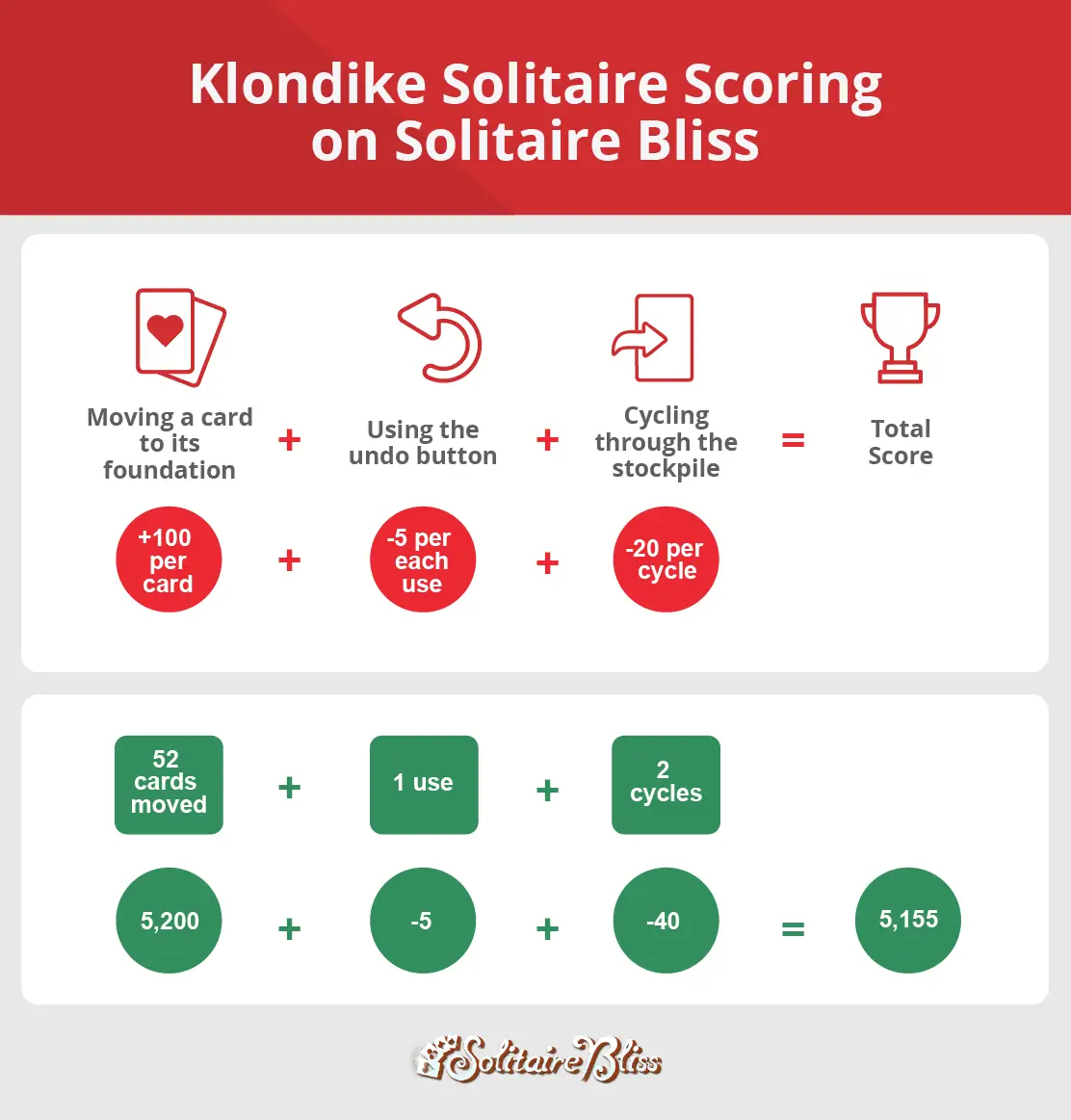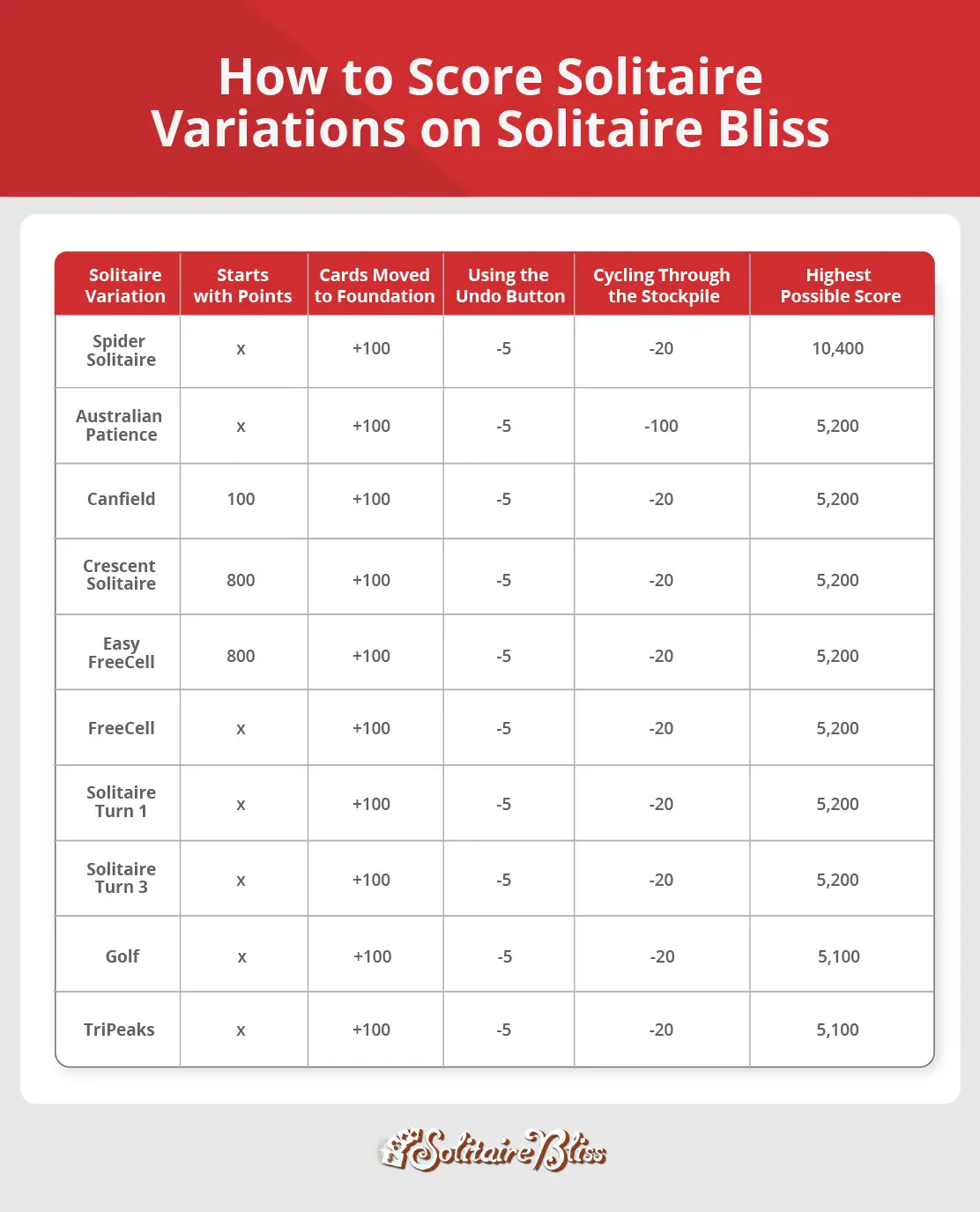How Solitaire Scoring Works: Tips for the Highest Score
Although Solitaire is a single-player card game, keeping score gives you a way to stay competitive, even if you’re just competing against yourself. A game of Solitaire uses just one standard deck of cards, and the objective is to move all the playing cards from the tableau and stockpile into four foundation piles, one for each suit and in ascending order.
To understand how scoring works, it’s important to know the basics of how to play Solitaire. You can only move face-up cards, and you arrange cards in the tableau by creating sequences of descending order and alternating colors. If you get stuck and can’t move cards, you can use the stockpile. Any face-up cards can be moved to foundation piles when they are available, and foundation piles must be separated by suit, begin with aces, and ascend in order to king.
Your score is impacted by your moves, which can give you points or penalties. Solitaire scoring systems can vary depending on the game’s version and the platform you’re playing on. If you’re looking to maximize your score, this post breaks down Solitaire scoring and offers tips and techniques to help you improve when you play Solitaire online.
How Is Solitaire Scored on Solitaire Bliss?
If you play Solitaire at Solitaire Bliss, you’re trying to accumulate points and get a high score. You can go as slowly as you need to because how long you take to finish the game is not a factor in scoring for any games on Solitaire Bliss.
Regardless of the Solitaire variation you play, Solitaire Bliss follows the same scoring rules for its games with some variation to account for differences in gameplay, setup, and difficulty levels. The following sections break down the differences for scoring.
Klondike Solitaire Scoring
The max score in any Klondike Solitaire game is the number of cards dealt multiplied by 100, so for Klondike, the highest score you can get is 5,200. The points and penalties for Klondike Solitaire include:
- Moving a card to foundation: +100 points per card moved
- Using the undo button: -5 points per use
- Cycling through the stockpile: -20 points per cycle

Think of it as having 5,200 points and then subtracting points for using the undo button and cycling through the stockpile. A stockpile penalty includes the first cycle through and all subsequent cycles.
For example, if you won the game, you moved all the cards (52 x 100 = 5,200), but if you cycled through the stockpile three times, you’d have to subtract 60 (3 x 20 = 60). And if you used the undo button twice, you’d have to deduct another 10 points (2 x 5 = 10), giving you a total of 5,130 points.
The stockpile penalty makes more of a difference in Solitaire Turn 3 compared to Solitaire Turn 1 because in Turn 1, you can access each card right away. In Turn 3, you might need more cycles through the stockpile to reach the cards you need.
Scoring Solitaire Variations
Like Klondike, the max score in any variation is typically the number of cards used multiplied by 100. For example, for Spider Solitaire it's 10,400 because it uses 104 cards. The only exceptions are Tri Peaks and Golf. Because they start with one card flipped over from the stockpile, the max score for those games is 5,100 instead of 5,200 since they use 52 cards.
Solitaire variations on Solitaire Bliss follow the same scoring rules but with a few nuances for some of the following rules:
- Moving a card to the foundation still gives you 100 points per card moved, and this rule applies to Tri Peaks and Golf even though they have just one foundation pile.
- Using the undo button penalizes your score with 5 points every time you use it without exception.
- Cycling through the stockpile penalizes your score with 20 points per cycle for Klondike-style games, 100 points per cycle for Easy Pyramid, and 100 points per cycle for Easy Australian Patience.
- Some variations start with points. Canfield starts with 100 points because one of the cards is already in the foundation. Crescent Solitaire and Easy Freecell start with 800 points because 8 cards are already in the foundation.

Other Ways to Score Solitaire
Solitaire scoring can vary depending on the version you’re playing and what platform you’re playing on. Variations on scoring will assign points and penalties to either specific card movements, time, or both, and Vegas-style Solitaire uses coins instead of points.
Standard Solitaire Scoring for Card Movements
You can use standard scoring rules when you play a Solitaire card game by hand, and you’ll likely see the following standards or some variation of them on other sites.
Card movements that assign points:
- Any card (stock or tableau) to foundation: 10 points
- Stock to tableau: 5 points
- Flip over a tableau card: 5 points
Card movements that assign penalties:
- Foundation back to tableau: -15 points
Solitaire Scoring Variations for Time
You may encounter various ways that apps and sites assess penalties or bonuses for time. For example, a site may subtract a set amount of points from your score for specific segments of time, penalizing you 2 points for every 10 seconds that elapse.
Or you may play a timed game and receive bonus points for winning within a specific timeframe. If you’re playing for time, you have to be efficient with your strategy and focus on moves that offer the most points.
Vegas Solitaire Scoring
Vegas Solitaire may sound advanced, but even beginners can enjoy playing this variation as it follows the same Solitaire rules for basic gameplay and scoring as Klondike. The only difference is that this variation uses coins in place of points for scoring.
With Vegas scoring, you don’t necessarily need to win, but you do want to gain the highest amount of coins you can with each game you play. You have to use 52 coins (one for each card) just to start a game, putting you down 52 coins when you first begin to play. But you are awarded with 5 coins for any card moved to its foundation pile. So it just takes 11 cards moved to their foundation to get you into a positive position with coins.
How to Get the Highest Solitaire Score
Because scoring depends on the version and site on which you play, take a moment to ensure you know how that game is scored. Then use Solitaire strategies as well as these tips to get the best score possible.
- Take your time. You may get penalized for time on some sites, but you may also get penalized for using the undo button if you rush and make a mistake. You don’t need to watch the clock with Solitaire Bliss since time isn’t factored into your score, but making thoughtful decisions no matter where you play ensures you make the best moves instead of careless mistakes.
- Use the stockpile as a last resort. To avoid cycling through the stockpile too much and piling up on penalties, work with the tableau as much as possible. In addition to avoiding penalties, this helps you focus on building sequences and uncovering facedown cards.
- Build long sequences on the tableau. This may feel counterintuitive, but most versions and websites offer the most points for cards that move to the foundation piles. However, you don’t get any points unless you actually win the game. Building long sequences in the tableau allows you to keep as many cards in play as possible, which increases your chances of winning and helps you easily move them to their foundation piles.
- Watch how the tableau changes. You should always assess the tableau at the beginning of a game, but you should also take note of how it changes. You may have to adjust your strategy as sequences get blocked or you find yourself unable to reveal hidden cards. So if you don’t notice, for example, that you’re neglecting a long column of hidden cards, you may have lost the opportunity to reveal them.
Earn a High Score on Solitaire Bliss
When you’re playing for a high score, you can start identifying weak areas of gameplay. Although Solitaire variations follow different setups and rules, you can build specific gameplay skills that can help increase your overall Solitaire score.
- Try easier variations, like FreeCell and Solitaire Turn 1, to build basic skills. If you’re struggling to break a scoring barrier overall or you can’t identify a weak spot, step down to a Solitaire version with an easier level of difficulty. If you’re playing Solitaire Turn 3, try Solitaire Turn 1, and if you’re playing Turn 1, try FreeCell. An easier version allows you to strengthen the basics of the game, such as sequence building or creating chain-reaction moves, without the stress of cards buried in a stockpile or limited space on the tableau.
- Increase the difficulty level to force restrained movement. If you’re too eager to build onto foundation piles or tend to focus on just one or two columns while leaving long stacks of hidden cards, a more difficult variation can actually help. A version like Canfield or Yukon may have more restrictions than Klondike, but those restrictions require you to be more disciplined and thoughtful with your movements, which can help you win easier versions more often and with a higher score.
- Use Spider Solitaire to practice sequences. Spider Solitaire is a completely different version of Solitaire that requires you to build same-suit sequences completely before they are placed into foundation piles. But long sequences are an effective strategy to win Klondike. So if you need practice keeping your focus on sequence building, Spider can give you a break from classic Solitaire games while still giving you skill-based practice.
If you’re ready to play Solitaire and get the highest score, then check out Solitaire Bliss, where you can play for free as often as you like without any downloads or sign ups!
Back to the Homepage

